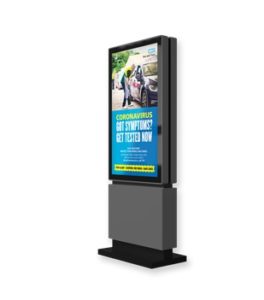Contents
atOptions = {
‘key’ : ‘ed2d486b6a0c8b18fb707e1672af5fcf’,
‘format’ : ‘iframe’,
‘height’ : 90,
‘width’ : 728,
‘params’ : {}
};
document.write(”);
When promoting a business or offering services to the public in the past, this used to be accomplished through static signage, such as billboards and posters. Although beneficial for its time, it lacks the flexibility and efficiency of a digital solution.
With digital signage, users can go beyond displaying one static piece of content and can use a wider variety of digital media. Some include videos, animation, social media feeds, and live data.
The use of video and images is nothing new, as video cassette recorders would be used to deliver these services, but there were still limitations, in that only one message could be relayed at the time,
Fortunately, the birth of digital signage has allowed businesses to benefit from a solution that can be used by an array of industries to meet tailored communication requirements.
In 2020, the digital signage market was valued at $29.9 billion (US). While this is an impressive statistic, the industry’s value is expected to increase by 7.5% between 2021 and 2028.
As such, many businesses, corporations, and organizations have leveraged the benefits of digital signage in many ways. However, a business must consider several factors to ensure it gets the most from digital signage.
Here’s what to do and what not to do with your digital screens.

Digital Signage Best Practices
Digital signage is transforming engagement for organizations around the world, but carrying out some best practices ensures you get value from your digital signage solution in every instance.
atOptions = {
‘key’ : ‘5cae3f4608881323ad30253876b29797’,
‘format’ : ‘iframe’,
‘height’ : 250,
‘width’ : 300,
‘params’ : {}
};
document.write(”);
The following is an overview of the considerations that should be made when implementing digital signage, which can help a business perfect the aesthetics of signage while ensuring the message is clearly portrayed.
Ensure Images Are High Quality
Digital signage options are available in various forms. Commercial digital signage displays vary between 32” and 98”, while digital kiosks start at 43”.
This means the images used must be high quality, so should be at least 1920 x 1080 pixels. Although software and hardware can adapt images to different sizes, if there aren’t enough pixels for larger displays, you risk your message becoming unclear due to pixelation. This can result in unreadable content, meaning your messages are lost.

Matching Screen Types to Use Cases and Viewing Times
The main purpose of digital signage is to enable effective communication. An Important first step to enabling effective communication is ensuring your screens match up to their use cases.
The way the information is relayed may also require an instant call-to-action, such as making a purchase. As such, the hardware being used needs to offer the functionality for digital signage to be prosperous.
Digital kiosks in malls are ideal for interactive maps, while High Brightness Displays are the perfect eye-catching addition to windows and the outdoors. The location of the digital signage often dictates how much time will be spent focusing on the signage.
Digital signage content and messages viewed by passers-by, such as shoppers, should average around 30 seconds in length. Signage placed within a business varies between 30 seconds and two minutes, based on viewers spending a small amount of time in the business.
Examples of these placements include reception areas and coffee shops. Long-term viewing patterns can range between two and 30 minutes, and are often placed in environments like restaurants, waiting for areas, and offices.
For digital signage to have the maximum impact, assessing the environment and timing is essential.
Environments, where viewers are present for some time, can be presented in a leisurely manner, while those designed to appeal to passers-by will need to ensure that information is communicated quickly, while in a manner that can be absorbed.
There can be other factors that determine how long people will focus on the content, but being realistic regarding viewing patterns ensures a business can tailor its message to connect with the audience within the appropriate time frame.

Large Fonts Work Best
The size of the font used on digital signage can depend on several factors, but there will be instances where digital signs are being viewed from as far as ten feet, so clear and large fonts are essential.
As a guide, a font between 20 and 30 points can be viewed from ten feet away, while a 100-point font can be viewed from 25 feet.
As well as ensuring potential customers can easily read your message, large fonts are also perfect for internal communications in corporations. Research shows that better communication between businesses and their employees can increase productivity as much as 25%.
Don’t Assume Digital Signage is Expensive
The price paid regarding digital signage depends on the hardware and software chosen, but many miss out on the benefits of digital signage on the assumption that it is expensive.
As the technology becomes more readily available, more software providers are offering varied packages to meet any budget. It’s worth noting that in most cases, you get what you pay for. We recommend creating a goal tick list of what you need your digital signage software and hardware to do. Then ensure that your software meets these requirements.

Don’t mix fonts
When visiting a website using several fonts, it can be difficult to decipher the message. As such, those in the web design industry rarely use more than two fonts when creating a website.
Maintaining font consistency will help create a strong and easily recognizable brand for years to come. For some global leaders, all you may need to do is read a few sentences in their branded font, and you’ll recognize the brand immediately without a logo in sight.
Some may assume that the use of several fonts can offer something unique, but in most cases, it can mean that the digital signage looks cluttered, which can be off-putting to potential viewers, meaning there is no clear communication between the business and the intended viewer.
Those wanting to communicate messages internally may find that lack of clarity leads to disengagement among employees, while those using a kiosk for digital wayfinding may find the instructions confusing and overwhelming,
Another top tip for fonts is to use ones that are simple and easy to read. The Sans-Serif family can be a good option as all the fonts are easy to read and widely accessible. The simple nature of Sans-Serif fonts ensures clarity in the message being delivered in every instance.
Don’t Use Too Many Colours
Knowing how many colors to use can be one of the most asked questions regarding digital signage. As with other aspects of digital signage, the colors used can depend on the nature of the campaign.
Those unsure of how many colors to use when employing the use of colors are advised to follow the 60-30-10 rule. This means the dominant color is used for 60% of the design, the secondary color is used for 30% of the design, and the last color is used for 10% of the design, normally acting as an accent.
A good tip is to follow your organization’s brand guidelines and keep them simple.

Don’t Overlook the Call-to-Action
Sometimes, there can be so much focus on the aesthetics of digital signage, that some overlook one of the most important components, a call-to-action.
A call to action provides a next step for the user and ensures maximum efficiency from your screens.
A call-to-action can come in several forms, but it should be relayed as much as possible in every message. For example, those wanting to streamline the check-in process should ensure that digital signage clearly highlights its benefits clearly, one of which could be a faster check-in.
If you are unsure where to start regarding your call-to-action, then why not use some of the following pointers.
- Ensure the call-to-action is clear and not hidden between images and other text.
- Make sure the benefits of the product or service are highlighted in a clear and concise way.
- Verbs are the most important words, as they create a sense of action or motion.
- Highlight the benefits rather than the features of the product or service.
There can be a small learning curve when first using digital signage, but its ease of use can mean communications are streamlined and can be updated in real-time. However, taking some time to focus on the smaller details ensures you get the most from digital signage in every instance.

